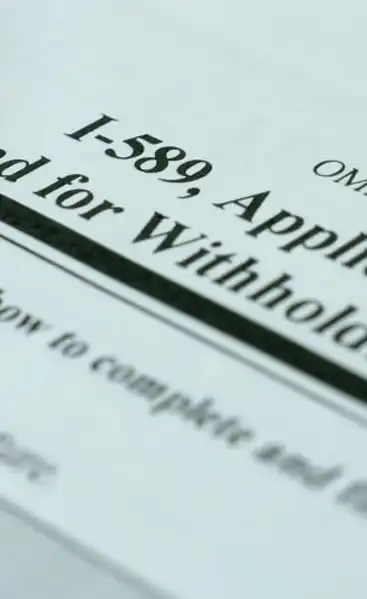MON – FRI (8am - 6pm)
Asylum eligibility in the U.S. requires demonstrating persecution or a well-founded fear of persecution based on race, religion, nationality, membership in a particular social group, or political opinion. Applicants must be present in the U.S. or at a U.S. port of entry.
See if you are eligible to file a Form I-589.
The persecution must be severe and linked to one of the aforementioned categories. Additionally, the applicant must file the I-589 form within one year of arrival unless extraordinary circumstances apply. It’s crucial to provide detailed evidence supporting your claim.


The asylum application process can be approached in two ways: affirmatively or defensively. Affirmative asylum is for individuals not in removal proceedings, it is requested using Form I-589. See how Form I-589 looks.
The applicant submits the application to U.S. Citizenship and Immigration Services (USCIS). In this case, the applicant initiates the process voluntarily and is not under immediate threat of deportation.
Defensive asylum, on the other hand, is applied when the individual is already in removal proceedings before an immigration judge. Understanding the distinction is vital, as it determines where and how the Form I-589 should be filed. Both processes involve rigorous documentation and interviews to assess the applicant's eligibility for asylum.
Navigating the asylum process can be complex. An experienced immigration attorney can help applicants avoid mistakes, provide legal arguments, and represent them during interviews and hearings. Don't hesitate to contact us right now.
After submitting Form I-589, applicants may be scheduled for an interview or hearing. Preparation is key to success.
The applicant should be ready to discuss their claim in detail and answer any questions from the asylum officer or immigration judge. Practicing responses and reviewing the submitted documentation can help applicants present their case more effectively. Having an expert attorney present during the interview can also provide additional support and guidance.

One of the most common mistakes is providing inconsistent or inaccurate information. All the details on your Form I-589 should be consistent with any other immigration applications you’ve previously submitted. Discrepancies, such as different dates, names, or events, can raise red flags and cause the reviewing officer to question the credibility of your entire application. It's important to double-check all the information you provide, ensuring that it matches your supporting documents and prior submissions.
Another frequent error is neglecting to complete all required sections. Form I-589 is detailed, and it’s crucial that every applicable question is answered thoroughly. Leaving sections blank or providing vague answers can result in your application being rejected. Additionally, be sure to include all necessary supplemental pages or attachments, especially if the space provided on the form is not sufficient to fully explain your situation. If you’re seeking legal guidance, contact Serving Immigrants to recieve help.
Consistency throughout the asylum application is essential. Inconsistent statements, whether in the Form I-589 or during interviews, can lead to a denial. The applicant must ensure that all details of their asylum claim, including dates, names, and events, match across all documents submitted to USCIS.
Providing affidavits or supporting statements from witnesses can help corroborate the applicant’s story, reinforcing their credibility.

Below are the possible outcomes that may result from submitting a Form I-360. We hope this information is helpful to you.
If the asylum application is approved, the applicant will receive protection in the U.S., allowing them to live and work in the country legally. After one year of receiving asylum, the applicant can apply for permanent residence (green card) and eventually U.S. citizenship.
If the asylum application is denied, the applicant may have the option to appeal the decision to the Board of Immigration Appeals (BIA).
Other forms of relief, such as withholding of removal or protection under the Convention Against Torture, may also be available. It is important to explore all legal options available in the event of a denial.

Asylum can be requested using Form I-589 by those who are physically present in the U.S. or at a port of entry and are not U.S. citizens. It is vital that the applicant demonstrates a well-founded fear of persecution if deported to their home country.
This form can be used by individuals seeking affirmative asylum, meaning they are not in removal proceedings, as well as those in defensive asylum, which is requested during removal proceedings. If you need legal advice, don't hesitate to contact us.
In this section, you will find a clear, detailed guide to completing Form I-589, the application for asylum and withholding of removal. Each step is explained to help you fill out the form correctly, avoiding common mistakes.
This includes your full name, date of birth, place of birth, nationality, and any other identifying details such as your Alien Registration Number (A-Number), if applicable. Ensure that all the information you provide is consistent with any previous immigration applications or documents you have submitted. Inconsistencies in your personal details can lead to delays or even a denial of your application.
Section A of Form I-589 requires detailed personal information, including your current address in the United States, your marital status, and the number of children you have. For your current address, provide a location where you can reliably receive mail, as USCIS will send important notices regarding your case to this address. If your marital status is complicated.
Section B is where you provide the details of the persecution you have faced or fear facing if returned to your home country. You must be as specific when describing incidents of persecution, including dates, locations, and the identities of the perpetrators. Clearly explain how these incidents are connected to one of the five protected grounds: race, religion, nationality, membership in a particular social group, or political opinion.
After completing the narrative in Section B, it’s important to attach supporting documents that corroborate your claims. This could include police reports, medical records, news articles, and witness statements. Each document should be clearly labeled and referenced in your written narrative. For instance, if you mention a specific incident of persecution in your story, attach any relevant evidence, such as photos of injuries, and label them accordingly.
Section C of Form I-589 requires you to provide additional information that may affect your application. This includes any prior asylum applications, criminal history, or other interactions with U.S. immigration authorities. If you have applied for asylum before, explain why you are applying again and how your situation has changed. If you have a criminal record, it’s important to be honest and provide detailed explanations along with any legal documents that can clarify your situation.
The final step in filling out Form I-589 is to sign and date the form in Section D. Your signature certifies that all the information you have provided is true and correct to the best of your knowledge. If you are using an interpreter to complete the form, they must also sign and provide their details. Similarly, if an attorney or accredited representative assisted you, they need to sign.
Before submitting Form I-589, it’s crucial to review the entire application for accuracy and completeness. Check each section to ensure that all required information has been provided and that all necessary documents are attached.
Once you have thoroughly reviewed your Form I-589 and compiled all necessary documents, it’s time to submit your application. Depending on your circumstances, you may need to submit your application online, by mail, or directly to a specific USCIS office or immigration court.
After submitting your Form I-589, you may be scheduled for an asylum interview with a USCIS officer or a hearing in immigration court. Preparation is key to success in this stage. Review your application thoroughly and ensure you can recall the details of your narrative and supporting evidence.
On the day of your asylum interview or hearing, arrive early and bring all necessary documents, including your Form I-589 and supporting evidence. Dress professionally and be prepared to answer questions about your application. During the interview or hearing, remain calm, honest, and consistent in your testimony.
After your interview or hearing, it’s important to stay informed about the status of your case. USCIS or the immigration court may request additional documentation or clarification, and it’s crucial to respond promptly. Keep an eye on any communications from USCIS or the court, and make sure your contact information is up to date.
If your asylum application is approved, you will need to take steps to maintain your status and plan for your future in the United States. This includes applying for work authorization, obtaining a Social Security number. After one year, you may be eligible to apply for a green card (permanent residency).
This section addresses the most common questions about Form I-589, the application for asylum and withholding of removal.
Form I-589, officially known as the "Application for Asylum and for Withholding of Removal," is a U.S. immigration form used by individuals seeking asylum in the U.S.
For applicants living in the United States file your application at the USCIS service center. For unaccompanied children you may be required to file your Form I-589 with the USCIS lockbox.
For applicants in removal proceedings, you must submit your Form I-589 to the immigration court where your case is being heard.
You should file within one year of arriving in the U.S., unless exceptions apply.
Processing times vary, typically several months to a few years. You also can check Case Processing Times here.
It is not mandatory to have an attorney to apply for an asylum visa, but it is highly recommended. In serving immigrants we have the best expert attorneys.